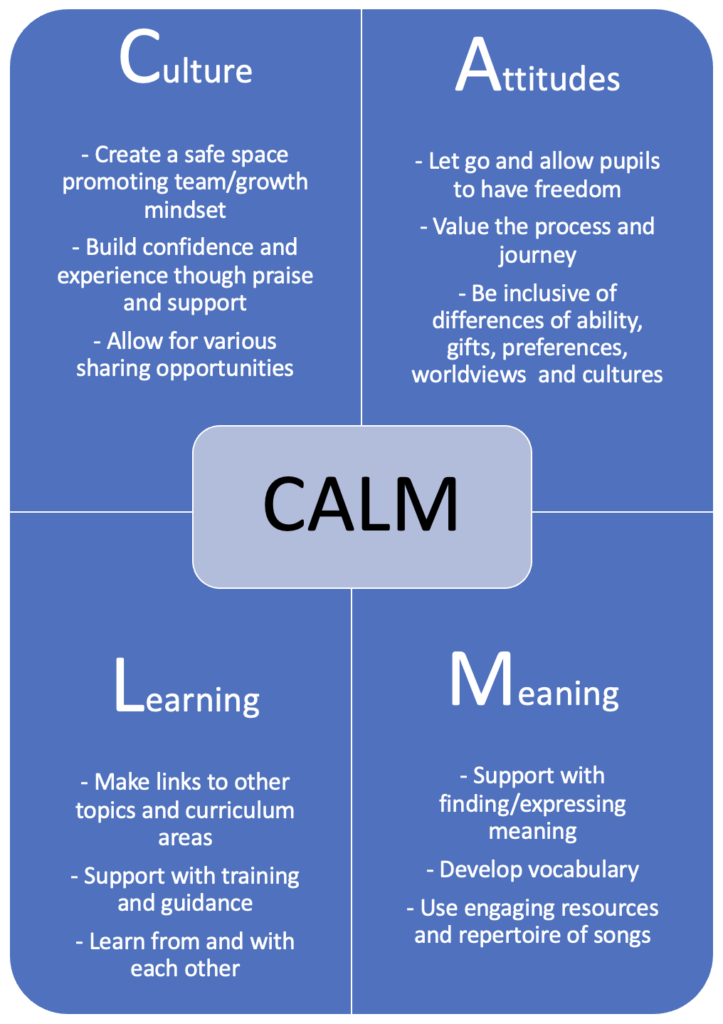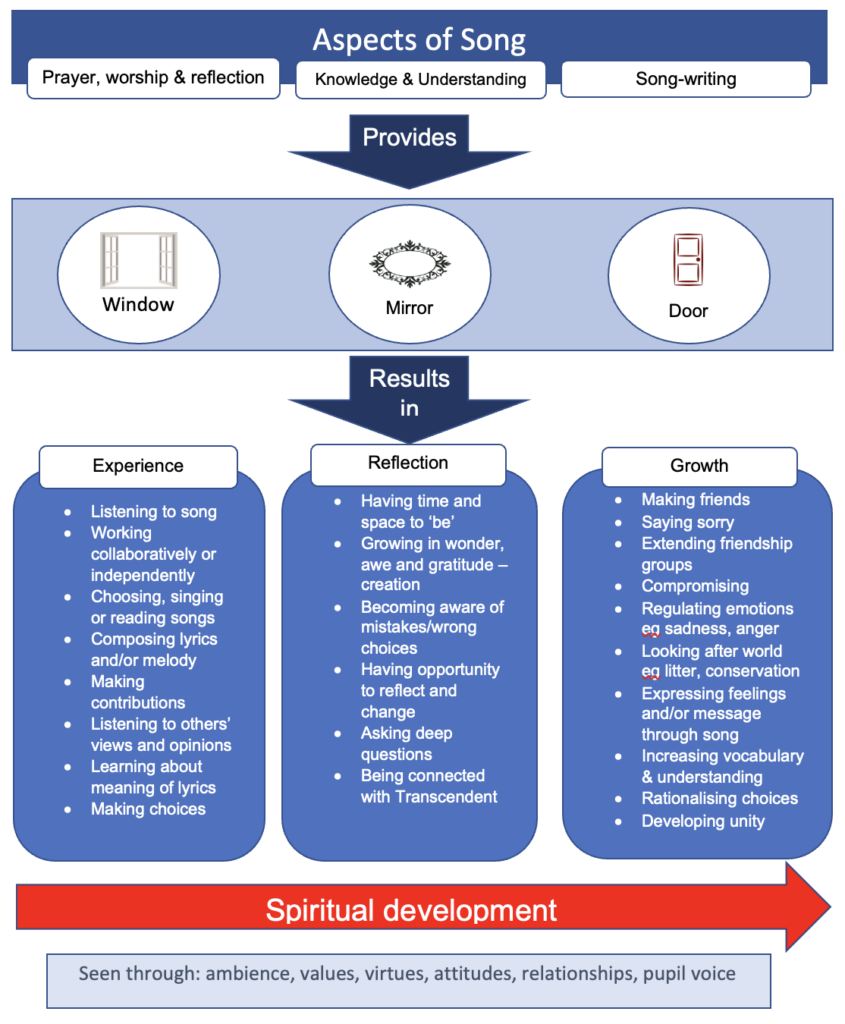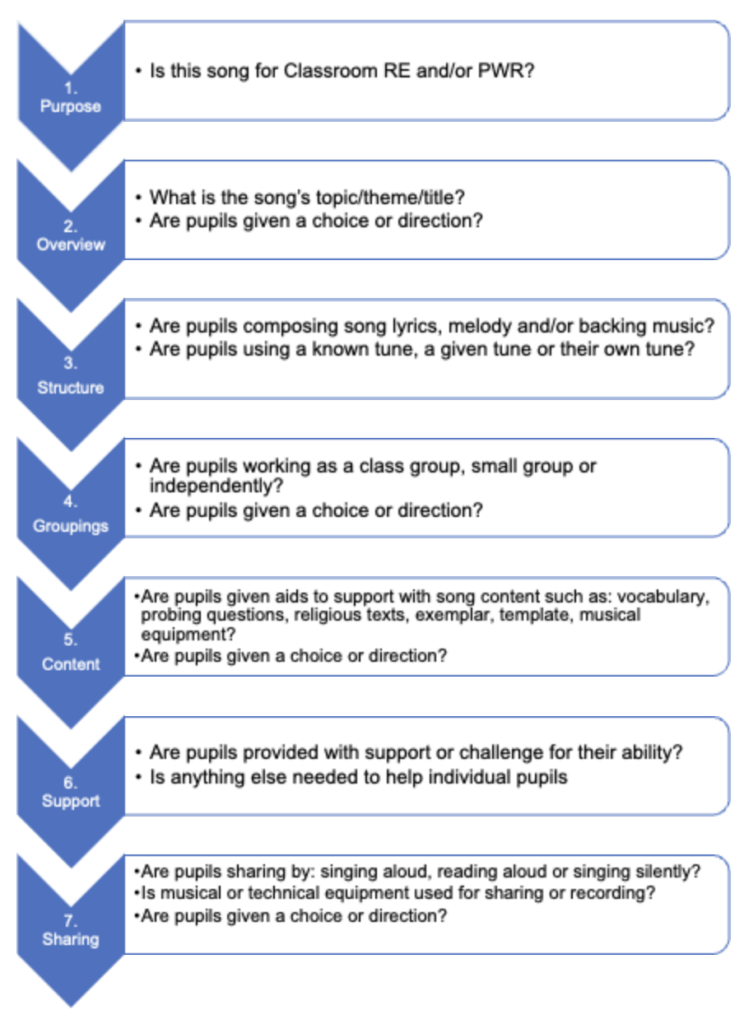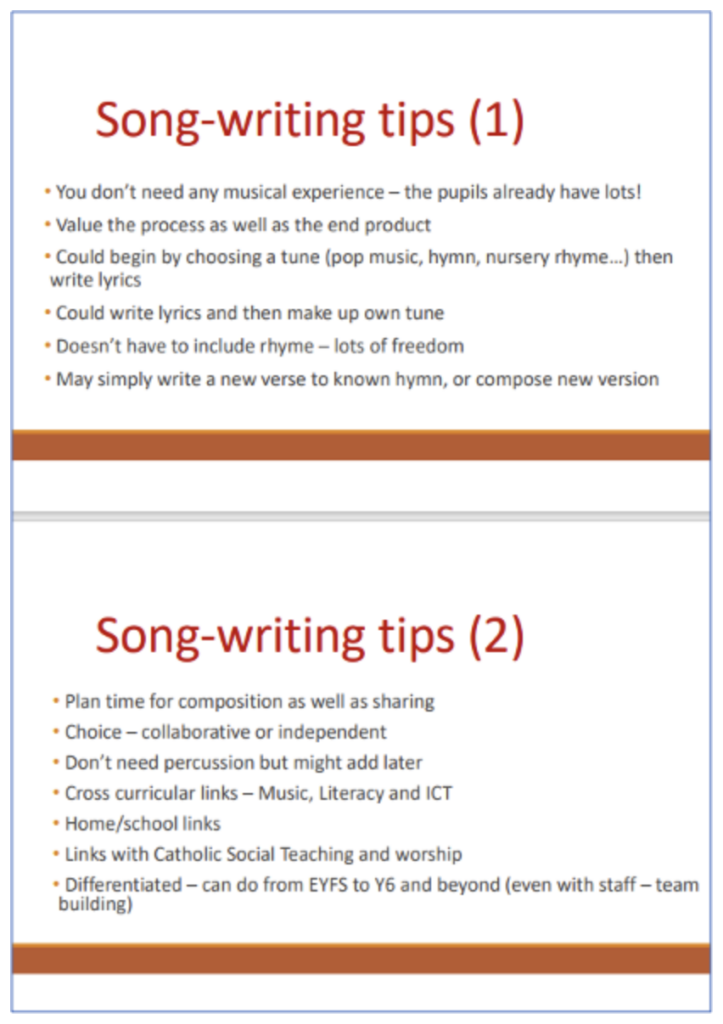Elaine Arundell
Developing spiritual wellbeing through song in RE
Inspiration
Having served as a primary teacher and RE coordinator for over 16 years and an AST in RE for a number of these, I have always championed the use of creativity in RE, for example through song. Ironically, I am not what would be considered ‘musical’ as I have never sung in a choir nor play an instrument; however, this has not been a barrier for me in developing pupils’ RE because I have found that primary children are able to bring their own experience of song into RE lessons. One of the reasons for my interest in this area is that I have witnessed how it has helped to create a ‘buzz’ in lessons, even for pupils who are generally disengaged; I also saw how it can encourage collaboration and build self-esteem and a sense of community. Therefore, for the last 20 years, I have used song as a tool in the primary classroom and supported others in doing so in my role as diocesan adviser over the last six years. Some of the creations over the years were published in an article I wrote for RE Today (Arundell, 2021).
Context
It was through my experience as adviser that I heard from a multitude of leaders about the negative effects of technology and covid on the wellbeing of our pupils during lockdown. As I work with faith schools, a number of leaders reported to me that one of the sore bruises of social distancing was the inability to gather as a community to worship or sing and this also impacted negatively on pupils’ sense of wellbeing and relationships. Aware of the myriad benefits of music on the both the individual and community and having embarked on an MA in RE, heavily supported by Culham St Gabriel’s Trust, I wanted to explore the use of song in RE in order to offer some way forward . Although there was a plethora of literature on spirituality and music, there was little in regards to song, particularly in RE, so I intended to fill this gap and investigate whether song in RE and worship was just a ‘fun’ activity or if it could have a meaningful impact on the spiritual development and wellbeing of pupils in key stage 2, and if so, how.
Spiritual development and song
For the purposes of this research, song in RE and worship referred to any type of religious song that was used within the RE lesson or outside of it including hymn practice, assemblies, prayer or liturgy while the use of song encompassed three ‘aspects’: composition, knowledge & understanding and prayer, worship & reflection. Having been inspired by Hay & Nye (2006), de Souza & Halafoff (2018) as well as Aristotle’s notion of eudaimonia and flourishing (Kraut, 2022; Honderich, 2005), spiritual development was therefore a combination of their definitions and, for this investigation, had five ‘characteristics’ which all pertained to connectivity and relationships, namely with: The Transcendent, Self, Others, Cosmos and Social Action, and which also related to Ofsted’s own definition (Ofsted, 1994; 2004; 2019). My intention was to discover which of the aspects could be used effectively and if song in RE might have an effect on each of the characteristics.
Song in RE – A case study
One of the greatest challenges of this research was that it was conducted in a primary school with which I was not familiar around Christmas and New Year 2020-2021. This meant that covid and other illnesses were still rife, staff turnover and absences were high and pressures on various members of the community were great. Gaining consent from parents and finding willing professionals with the time and energy to support with the project was, therefore, not straight-forward initially and I needed to be creative with proceeding with the project so as to ensure that wellbeing was at the very heart of it. Another deanery school was then invited to take part and all key stage 2 classes from both schools were involved. As a result, both qualitative and quantitative data were used for this case-study research, with surveys being completed by 180 pupils and 9 teachers. Interviews were conducted with small groups of diverse pupils (45 pupils in total) and one-to-one interviews with 9 teachers, with a wide range of experience and level of responsibility, took place.
While the two schools were similar in their context as they were both Catholic schools in the same deanery with creativity in RE on their action plan, there were significant differences in approaches. School A had used songs in the past for worship and reflection as well as for listening and understanding during RE lessons and hymn practice; however, they had not composed songs in RE prior to this project and so I led staff training using some of the examples and tips given in the RE Today article (Arundell, 2021). The headteacher of this School A then tasked all key stage two classes with composing their own song to share at their Christmas concert having had three months to work on these. School B, on the other hand, were also confident in using songs for worship and reflection as well as listening and understanding. However, they were not unfamiliar with the concept of composing songs in RE, although this was mainly led by the school’s music coordinator with class teachers free to also use song within the RE classroom should they wish.
Findings
Due to the diversity in approach and experience as well as the wide spectrum of participants, the data was quite rich and robust and, although it was varied, the majority of participants agreed on several points, the main one of which was unanimous that song in RE created a sense of happiness and calm within the classroom. As a result of listening to, singing or composing religious songs, pupils reported that they were less likely to feel angry or anxious and reported that this can have a positive impact on their actions such as making friends again or looking after the environment by picking up litter. All teachers reported that using songs in RE increased their memory and the vast majority of pupils responded that choosing songs in RE and worship made them more engaged. One of the most surprising findings was that over half of the 180 pupils surveyed said that they would prefer to sing their song silently as opposed to almost a fifth who would rather read it aloud and almost a third who would enjoy singing it aloud.
Overall, the key findings were that using song in RE and worship can have an impact on all five of the characteristics of spiritual development and that all three aspects of song can be effective in developing the spiritual wellbeing of pupils in KS2. Perhaps the finding of greatest significance, however, was that the use of song in RE naturally encouraged the practice of all Gospel values (Richter, 2000) and virtues (CDCEF & CBCEW, 2020) and participants spoke indirectly about these, although they were not asked specifically about them. For example, pupils described the love, peace or courage they felt as a result of singing, listening to or composing religious song and how the mood created through the song influenced their actions in a positive way. Through close analysis of the data, it was possible to match all of the Gospel values and virtues, as well as all of the Holy Spirit’s gifts (New International Version [NIV] 2011, Is 11:2-3) and fruits of the Holy Spirit, (NIV, Gal 5:22-23) to responses of either pupils or staff. This may be significant because the values and virtues are not limited to any faith or worldview but cross many boundaries which music and song also can.
What next?
To support schools with the process of using song, particularly with composition of song in RE which is the aspect with which schools are less familiar, several models have been created and some of these are included below. These models have been shared at RE Coordinator conferences in both Southwark and Westminster dioceses as well as in various schools in which I am the adviser along with several examples of songs created by pupils, either as a whole class, small group or individually. Some of these songs have a known melody of a religious or popular song while others had both the melody and lyrics written by the pupils. All findings from this research have been shared in detail with schools A and B along with various other models and resources so that they can move this forward in their own contexts; the use of song in RE has also been mapped to the expectations for the new national inspection for Catholic schools so that it further reassures colleagues of the myriad benefits of using song in RE.
Over the past year, I have also been able to link this project to my diocesan work on Racial Justice, Equality and Diversity as pupils have had the opportunity to create songs based on this important theme; these have been shared on the diocesan website with several pupils having had the opportunity to share theirs publicly in front of an audience of 1000 people in Westminster Cathedral. Going forward, I hope to research this area in greater detail through more academic study, perhaps by exploring song in RE and worship in non-Catholic schools, by looking specifically at only song in RE lessons, or by doing a longitudinal study. I also aim to share and collate guidance and examples of good practice on song in RE and worship through my courses and resources and I am open to opportunities in which to share and develop this learning more widely.
References
Arundell, E. (2021b). ‘Song-writing in RE: a top ten of ideas’, RE Today, May 2021 pp. 22–23.
de Souza, M. & A. Halafoff. (eds.). (2018). Re-Enchanting Education and Spiritual Wellbeing: Fostering Belonging and Meaning-Making for Global Citizens. London and New York: Routledge pp. 1–22.
Department of Catholic Education and Formation Catholic Bishops’ Conference of England and Wales [DCEF & CBCEW]. (2020). Formation in Virtues: Educating the Whole Person. Available at: https://www.catholiceducation.org.uk/images/Formation_in_virtues_Final.pdf Accessed on 23rd February 2023.
Hay D. & R. Nye. (2006). The Spirit of the child (Revised Edition). London: Jessica Kingsley Publishers.
Kraut, R. (2022). Edward N. Zalta (ed.). ‘Aristotle’s Ethics’, The Stanford Encyclopedia of Philosophy. Available at https://plato.stanford.edu/entries/aristotle-ethics/ . Accessed on 28th May 2022.
Mills, L. (1997). The Doughnut and the Hole: Spiritual Development in Primary Schools. Farmington Institute Research Projects. Available at http://www.farmington.ac.uk/index.php/ps12-the-doughnut-and-the-hole/ Accessed on 1st June 2022.
Mills, L (2019). ‘Growing Together? Spiritual development in schools and communities’. In Rickett, A. (ed.), ‘Spiritual Development: Interpretations of Spiritual Development in the Classroom’. The Church of England Education Office. Available at https://www.stalbans.anglican.org/wp-content/uploads/CE-Spiritual-Development-Interpretations-in-the-Classroom.pdf Accessed on 16th May 2021.
New International Version. Biblica, 2011. Bible Gateway. Available at www.biblegateway.com/versions/NewInternational-Version-NIV-Bible/ Accessed on 29th May 2022.
Office for Standards in Education, Children’s Services and Skills [Ofsted], (1994) Handbook for the Inspection of Schools. Part 4. Inspection Schedule Guidance. Consolidated Edition. London, HMSO. Available at https://www.gov.uk/government/publications/school-inspection-handbook-eif/school-inspection-handbook updated 14th April 2022 https://www.gov.uk/government/publications/school-inspection-handbook-eif/summary-of-changes Accessed on 20th May 2022.
Office for Standards in Education, Children’s Services and Skills [Ofsted], (2004). Promoting and evaluating pupils’ spiritual, moral, social and cultural development. London, HMSO. Document reference number: HMI 2125. Available at https://dera.ioe.ac.uk/4959/1/Promoting_and_evaluating_pupils%27_spiritual%2C_moral%2C_social_and_cultural_development_%28PDF_format%29.pdf Accessed on 30th May 2022.
Office for Standards in Education, Children’s Services and Skills [Ofsted]. (2019). School inspection handbook. Ofsted. [Online]. Available at https://www.gov.uk/government/publications/school-inspection-handbook-eif. Accessed on 29th May 2022.
Richter, K. (2000). ‘Gospel Values Across the Curriculum’. St Mary’s Press. Available at https://cici-online.org/catechetical-connections/gospel-values Accessed on 23rd February 2023.
Model A: Journey from experience to growth and transformation using song (inspired by Mills: 1997, 2019)
Model B: The process of song composition for the use of song in REW for SDW
Model C: CALM Model to summarise findings

Model D: Song-writing tips


